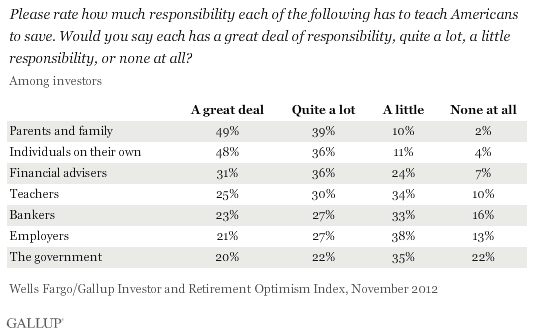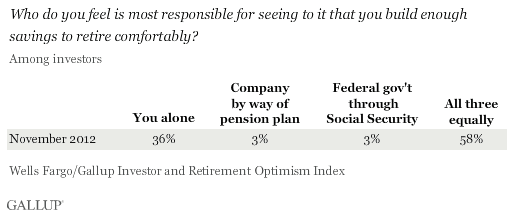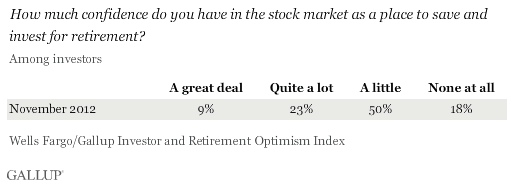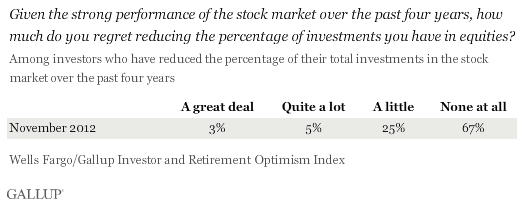PRINCETON, NJ -- U.S. investors are most likely to believe families (88%) or individuals themselves (84%) should be responsible for teaching Americans to save -- with more than eight in 10 saying each has a great deal or quite a lot of responsibility. Financial advisers (67%) and teachers (55%) place third and fourth, followed by bankers (50%), employers (48%), and government (42%).

The Wells Fargo/Gallup Investor and Retirement Optimism Index quarterly survey was conducted Nov. 9-17, 2012, with a random sample of 1,024 investors, with about half of the sample responding to questions focused on saving.
Encouraging Americans to Save for Retirement Is a Joint Responsibility
A separate question in the poll finds eight in 10 investors thinking the Obama administration should make it a national priority to encourage Americans to save.

Of course, preparing for retirement is one of the major reasons Americans save. When investors are asked whether they themselves, their employer, or the federal government is most responsible for seeing to it that they build enough savings to retire comfortably, 58% suggest all three are equally responsible. Another 36% say building enough retirement savings is a responsibility of the individual alone, while 3% think it is an obligation of either employers or the government alone.

Many Investors Have Little Confidence in the Stock Market
While investors think saving should be a major priority, two in three say they have little or no confidence in the stock market as a place to save and invest for retirement.

Average investors' continuing concern about conditions in the equity markets is reflected by their feelings about investing over the past four years. Forty-five percent say they have reduced the percentage of their total investments in the stock market over the past four years. Despite the enormous gains in the market over this time, 67% say they have no regret at all about reducing their percentage of equity holdings and another 25% say they have little regret. It appears investors remain more concerned about maintaining the value of their investment principal than how much of an investment return they get on it.

Implications
Americans learned a hard lesson about overleveraging -- having too much debt relative to their assets and income -- during the financial crisis. When credit dries up and jobs are being lost, it is essential to have savings to fall back on in order to maintain the health of one's financial position. Given the length and depth of the recession and financial crisis, it is not surprising that investors now see saving as a top priority. Further, many investors are worried about the future of Social Security. So again, it is not surprising that they see it as essential that Americans build their savings if they want to retire comfortably.
However, it is noteworthy that American investors overwhelmingly see it as the responsibility of the family and the individual to teach Americans to save. They do, however, say 401(k)s and other tax-advantaged accounts are extremely (43%) or very (40%) important to achieving a comfortable retirement. This does not seem to be an unreasonable position, given the way the Fed is artificially holding down interest rates and thus the rate of return available to savers.
Survey Methods
The Wells Fargo/Gallup Investor and Retirement Optimism Index results are based on questions asked on the Gallup Daily tracking survey of a random sample of 1,024 U.S. adults having investable assets of $10,000 or more from Nov. 9-17, 2012. For results based on the entire sample of national adults, one can say with 95% confidence that the maximum margin of sampling error is ±3 percentage points.
For results based on the sample of 625 nonretirees, one can say with 95% confidence that the maximum margin of sampling error is ±4 percentage points. For results based on 394 retirees, one can say with 95% confidence that the maximum margin of sampling error is ±5 percentage points. For results based on the 521 respondents answering questions on savings, one can say with 95% confidence that the maximum margin of sampling error is ±5 percentage points.
Interviews are conducted with respondents on landline telephones and cellular phones, with interviews conducted in Spanish for respondents who are primarily Spanish-speaking. Each sample includes a minimum quota of 400 cellphone respondents and 600 landline respondents per 1,000 national adults, with additional minimum quotas among landline respondents by region. Landline telephone numbers are chosen at random among listed telephone numbers. Cellphone numbers are selected using random-digit-dial methods. Landline respondents are chosen at random within each household on the basis of which member had the most recent birthday.
Samples are weighted by gender, age, race, Hispanic ethnicity, education, region, adults in the household, and phone status (cellphone only/landline only/both, cellphone mostly, and having an unlisted landline number). Demographic weighting targets are based on the March 2011 Current Population Survey figures for the aged 18 and older non-institutionalized population living in U.S. telephone households. All reported margins of sampling error include the computed design effects for weighting and sample design.
In addition to sampling error, question wording and practical difficulties in conducting surveys can introduce error or bias into the findings of public opinion polls.
For more details on Gallup's polling methodology, visit www.gallup.com.
